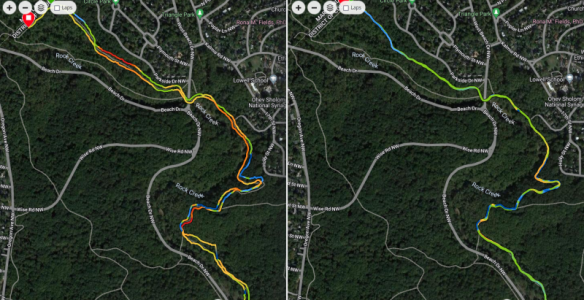Garmin Epix (Gen 2) Discussion
I got a Garmin Epix watch (Gen 2) for Christmas and have been using it since then. Previously I had a Garmin Venu that I used since Christmas 2020.
I wanted to upgrade from the Venu because the AMOLED screen was having some burn-in issues (my understanding was that newer Venus didn't have this issue, so it was something that they figured out) and the battery life with GPS was getting a little short. But I
loved the AMOLED screen and the touchscreen capability, so my upgrade had to have those. The Epix is very expensive, but various personal reasons got it to work out.
I got the sapphire edition with white band and titanium watch bezel.
First, the biggest day-to-day difference I notice is that the GPS locks on
very fast. It's also much more accurate and precise. The Epix has dual-band GPS, which uses both the US GPS satellites and the European Galileo satellites. Wow, it makes a big difference! The image below shows the GPS track from the same trail that I run frequently: the left is the Venu track and the right is the Epix track.

I ran this trail out-and-back; it's a wooded trail and the parts in the center-right part of each image also have a quite a bit of elevation gain/loss along with changing direction quite a bit. You can see that the Venu track (left) frequently does not overlap on my out and back portions, and sometimes you can see the gray path on the map, indicating that the GPS track didn't fall on the mapped path. The Epix track on the right is very tight, overlapping both itself and the mapped path. For scale, the distance along the path that this covers is about 1.5 miles.
I'm not sure how much it really matters to get this better GPS tracking, but it's very satisfying. Since I am ding a lot more trail running now, perhaps it will end up being useful - at least I should have better distance measurements.
Following up on the better GPS, my splits from the Epix include a GAP split as well. This is so nice to see, especially with trail running and all the hills. From the few trail runs that I've done so far with the Epix, my GAP pace is actually pretty consistent, even though a walk up the steeper hills. Nice. I wonder if it will take the GAP into account when calculating things like VO2max. It may be doing so, because so far my VO2max has not dropped with more trail running like it usually does.
I can also display the grade of my path on the fly - I have it set on one of the display screens on the watch for my runs. I show on the screen the cumulative ascent and descent, a chart of the elevation for my run (that updates in real time), and the grade of the path where I am right then. Of course, it's showing the grade based on some distance behind me, so it lags a bit. However, I have liked the verification that some of my hills really
are steep. Ha.
One of the big things the Epix has is maps. Unlike the latest Fenix (I think), the maps for the US (and some other areas?) are pre-loaded and I didn't have to buy or download them. I have needed reading glasses in the past few years, so I wasn't sure I'd bee able to get anything out of the maps, but so far, I have been able to read them when I've checked. I really haven't used them much yet. As expected, when I go for a run, the map has a line trailing the path where I've been.
The battery life of the Epix is amazing so far. I have kept up my habit of charging it daily while I shower, but I really could go for five days or more, even with my normal GPS use and be OK. I don't put the screen to "always on" - it is "gesture on", but I think I have it at its max brightness.
Some more eclectic things. It has a tennis indoor/outdoor activity, which is nice to me. Oddly, it doesn't have a built in activity for indoor walking - the only similar indoor thing is treadmill running. You can use that activity and then later change it to "casual walking" or something, but I thought it was odd.
Now on to training measurements. I hadn't really thought about the additional training measurements and tools that the Epix would have that my Venu does not.
Each morning it gives me a "training readiness" score that seems to be based on my sleep quality, recovery time, and HRV (Heart Rate Variability) status among other things. First, I like that it evaluates my sleep quality. Generally I don't seem to have good sleep quality, partly because I rarely get more than about 6.5 hr of sleep. It chides me when my sleep quality is especially poor ("focus on your sleep quality" or some such). My HRV has only been measured for long enough to start using it in the last day or so, and so we'll see where that goes.
Mostly my training readiness has been "low" or even "poor" and so it will suggest a run plan for the day based on that, which currently I have been ignoring. But it's interesting to see. I kind of wonder if I keep training with "low" training readiness if it will decide that maybe it shouldn't be "low" and adapt. We'll see.
The "training status" is also interesting. It rates each activity as being productive, unproductive, maintaining, or recovery (those are the ratings I've seen so far). Interestingly, my activities since Jan. 3 have been productive even though generally speaking my training readiness has been low.
It also calculates my exercise load. I think
@DopeyBadger does this with some magic, but I've never calculated it for any of my activities. It has been quite interesting to see that the load is for each activity. For example, a CV interval run that I did on Jan. 10 was a load of 176 with a "benefit" to my VO2max, while an easy run was a load of 73 with a benefit to my base. At least those seem to line up with my expectations. Then it adds up my "acute load" and tells me if it's in the optimal range to maintain or improve my fitness - so far, I've been in that optimal range.
Obviously the watch can only measure so much about me, so I have to take its measurements with a grain of salt, but it will be interesting to see how these measurements change as my training plan progresses.
One of the odd this about the training load measurements and calculations is it seems to have a set distribution of load that it wants to be anaerobic, high aerobic, and low aerobic, and if your activities aren't hitting that distribution, it tells you what you're missing. However, that seems to assume that you're training for a certain set of goals, which I am not - I would probably want much more of a focus on low aerobic activity right now. From what I have found, there doesn't seem to be a way to change this.
Anyway...these are my thoughts so far. We'll see how my life and training evolves with the Epix.








